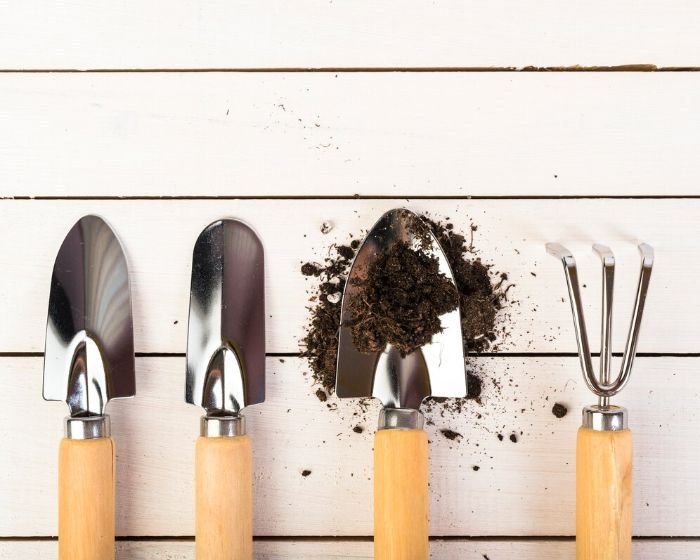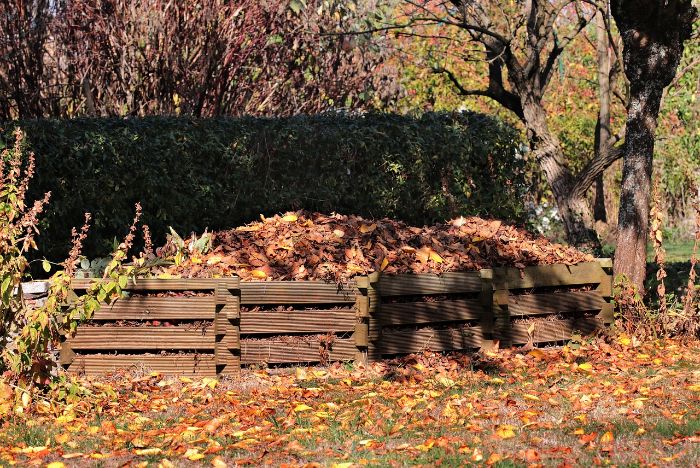Gardening needs the right tools for success. Every gardener must have a garden trowel.
But how do you pick the best one? Is stainless steel better than plastic? Does the handle’s material really make a difference? What about the blade’s design and features?
This guide will dive into garden trowels. It aims to arm you with everything you need to choose wisely. No matter your level of experience, finding the perfect garden trowel will be easier with this guide.
Key Takeaways:
- Choosing the right garden trowel is crucial for successful gardening.
- A garden trowel is a versatile tool used for digging, planting, and weeding.
- In this guide, we will cover different types of garden trowels, material considerations, handle types and ergonomics, blade design and features, durability and maintenance, and factors to consider when choosing a trowel.
- By the end of this guide, you’ll have all the knowledge you need to select the perfect garden trowel for your specific gardening needs.
Table of Contents
About Garden Trowels
Garden trowels are key for both new and expert gardeners. They help with many tasks and are a must. From digging holes to moving small plants, they’re handy for any garden job.
These tools are perfect for planting, moving small plants, and fighting weeds. Their small size and strong metal make them great in tight spots. Their shape is ideal for careful work without hurting plants.
Wondering why garden trowels are so important? Let’s see how they perfect your gardening work.
The Importance of a Good Garden Trowel
A great garden trowel works almost like your own hand. It fits perfectly and lets you handle gardening work easily.
It’s also super for planting things right. It makes the perfect hole for plants with minimal root damage, helping them grow strong.
And moving young plants is a breeze with a quality trowel. Its design keeps these plants safe during the move.
Need to remove weeds? A garden trowel with a sharp edge is your friend. It helps clean up without harming your garden.
Overall, a top-notch garden trowel is a game changer. It makes gardening simpler for everyone, from amateurs to pros.
Overview of Trowel Uses in Gardening
Garden trowels have many uses. They shine in tasks like planting, moving plants, and pulling weeds. They’re also good for loosening soil, creating spaces for seeds, and picking small crops.
As shown, a garden trowel is a hardworking tool. Every gardener should have one, thanks to its size, strength, and ease of use.
Types of Garden Trowels
There are many types of garden trowels, each best for certain jobs. You might need one for moving plants, digging, weeding, or other tasks. Picking the right trowel is key for good gardening.
Transplanting Trowels
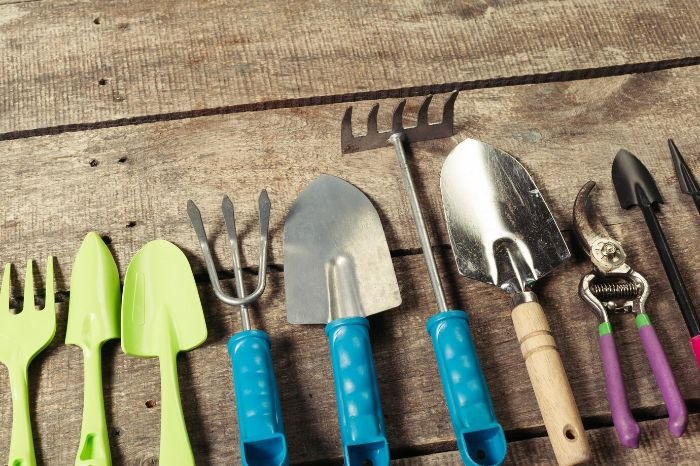
Transplanting trowels help move plants without hurting their roots. They have a slim, pointed blade for easy, careful digging. This makes them perfect for moving seedlings or plants without messing up other plants nearby.
Digging Trowels
Digging trowels are great for many jobs, like digging holes or creating irrigation trenches. They’re stronger and wider than transplanting trowels, giving more power for tough digging. They’re essential for making planting areas ready without much effort.
Weeding Trowels
Weeding trowels fight the never-ending battle against garden weeds. With their sharp, narrow tips, they pull weeds out easily. They not only make your garden look better but also help your good plants by eliminating competition for resources. Their small, easy-to-use design is perfect for keeping weeds at bay.
Specialty Trowels
There are also special trowels for specific gardening needs. Some are for planting bulbs, others for handling delicate seedlings. There are also trowels for putting soil in pots or doing precise work in small spaces. These specialty trowels offer unique help for special gardening tasks.
Knowing about the different garden trowels helps you pick the right one for you. Whether you’re moving plants, digging, weeding, or doing something special, the right trowel can make all the difference. It makes gardening more fun and easier.
Material Considerations
There are many garden trowel materials to choose from. Each one has its own benefits and drawbacks. The material affects how well the trowel works and lasts. We’ll look at stainless steel, aluminum, carbon steel, and plastic/composite. This will help you pick the right trowel for your gardening needs.
Stainless Steel Trowels
Stainless steel trowels are loved for their strong build. They don’t rust easily and keep their sharp edge. They look nice, are easy to clean, and are great for precise gardening work. Stainless steel trowels last a long time and are a solid choice for many garden tasks.
Aluminum Trowels
Aluminum trowels are light and easy to use. They help if you’re not too strong or have trouble with your hands. They also don’t rust. Aluminum trowels are a good pick for anyone who gardens often but doesn’t need a super tough tool.
Carbon Steel Trowels
Carbon steel trowels are tough and don’t cost a lot. They are strong enough for heavy work. But, you need to keep them clean to avoid rust. If you face tough soil often, these trowels are up for the challenge.
Plastic and Composite Trowels
Plastic and composite trowels are light and easy on the hands. They are low-maintenance too because they don’t rust. These trowels are a good budget pick and come in many colors. They are best for easy garden tasks or those with certain needs.
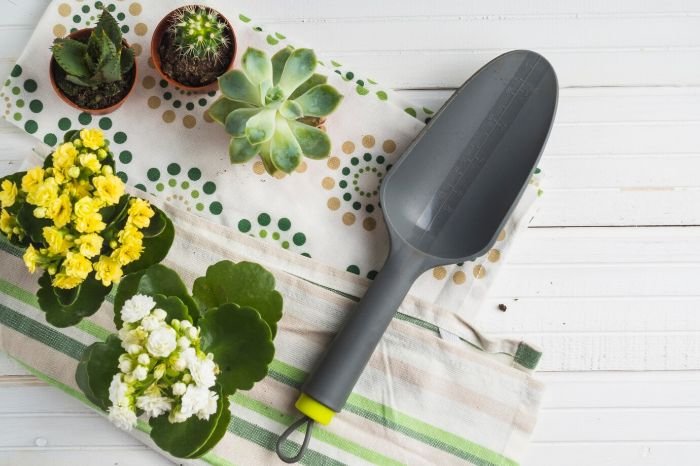
Think about how you garden, the soil you use, and what you like in a trowel. The right trowel will be easy and comfy to use for you.
Handle Types and Ergonomics
The handle of a garden trowel plays a big role in comfort. It’s key to making gardening easier. There are many handle types to choose from. Let’s look at the options and their benefits.
Wooden Handles
Wooden handles offer a classic look and feel. They let gardeners connect more with their work. With a wooden handle, you get a strong, comfortable hold. This means you have better control when you’re digging or planting. Also, wood can absorb shocks, protecting your hands and wrists. The natural warm look of wood makes any garden tool more inviting.
Plastic and Composite Handles
In recent years, plastic and composite handles have become popular. They’re durable and light. These handles are made of top-notch materials. Plastic and composite handles are OK with water, bad weather, and bugs. They provide a good grip and reduce hand tiredness. They come in many colors and designs. This lets gardeners pick what suits their style, all while using modern, practical materials.
Cushioned and Ergonomic Handles
Cushioned and ergonomic handles put user comfort first. They have a soft grip and fit well in the hand. The cushioning lessens hand and finger pressure. This lowers the chances of getting hurt. These handles are also designed to keep your wrist straight. This helps avoid injuries from doing the same movements over and over. They are perfect for people with soft hands, arthritis, or those who want the best in ergonomic features.
Blade Design and Features
The blade of a garden trowel is crucial to picking the right tool for gardening. Various blade designs and features help a trowel work better. We’ll look at blade shape, size, serrated versus smooth edges, and the benefits of extra features.
Blade Shape and Size
Blade shape and size matter a lot when choosing a garden trowel. The blade’s shape affects how well it does certain tasks, like digging holes or moving soil. A pointed tip works for precise actions, and a wider tip is better for bigger jobs. The blade size should match your hand and project size to work comfortably.
Serrated vs. Smooth Edges
Blades can have serrated or smooth edges. Serrated edges cut into hard soils and roots better. Smooth edges work nicely in softer soils for neat, easy cuts. Think about your soil and the work you do to pick the right edge type.
Measuring Scales and Other Features
Many trowels have extra tools like measuring scales. These help with planting depth and spacing in detailed projects. Built-in scales can make gardening easier. Think about your gardening style to see if these features would help you.
Durability and Maintenance
It’s vital to make sure a garden trowel lasts a long time. A durable trowel handles the hard work of gardening and keeps working well over time. To know if a trowel is well-made, look at a few key things.
Assessing Build Quality
First, check what the trowel is made of. Trowels made of stainless steel, carbon steel, or tough plastic are best. These materials are strong and won’t rust, so your trowel can handle all kinds of weather. Make sure the trowel is put together well and feels sturdy. Trowels with weak handles or blades can be a problem because they might bend or snap when you’re using them.
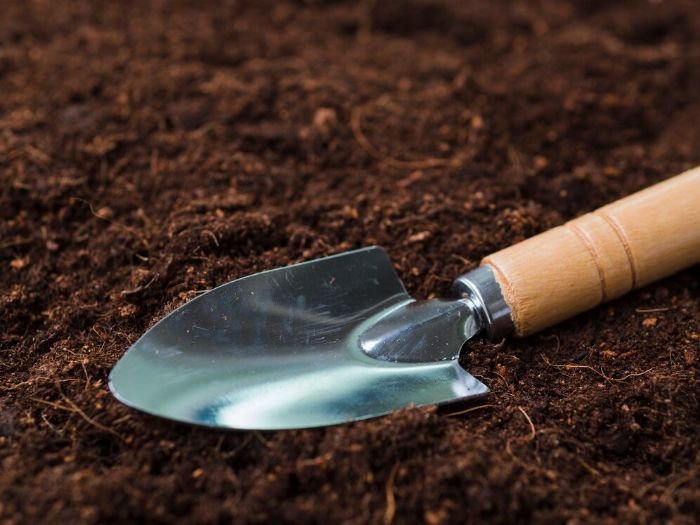
Maintenance Tips to Extend Trowel Lifespan
Keeping your garden trowel in good shape is key. Stick to these maintenance tips to make your trowel last longer:
- After each use, clean your trowel with water and a mild soap. This removes any dirt on it.
- Always make sure your trowel is completely dry before you put it away. Use a cloth or towel to dry it off.
- If your trowel has a wooden handle, treat it with linseed oil or a wood preservative. This helps prevent it from cracking or breaking.
- Check your trowel often for any damage. If you find a problem, fix it or get a new trowel to keep safe.
Following these care steps will make your trowel last a lot longer. This way, your trowel stays strong and reliable for your gardening tasks.
Choosing the Right Trowel for Your Gardening Tasks
Gardening needs the right tools to thrive. One of the key tools is the garden trowel. Different tasks need different trowel types. We will help you pick the best trowel for your gardening needs.
Factors to Consider for Different Gardening Activities
It’s important to think about what you do in the garden before picking a trowel. Each task asks for special trowel features. Here’s what to keep in mind:
- Soil type matters a lot. Use a wide-bladed trowel for loose or sandy soil. A pointed tip trowel is better for dense, clay-like soil.
- Choose a trowel with a long blade for deep digging needs. It helps you reach further down without much effort.
- For transplanting seedlings or working with big plants, go for a trowel with a wider blade. It moves more soil at once.
Matching Trowel Features to Specific Needs
Finding the right trowel means connecting its features with what you need. Look for these trowel qualities:
- If your hands or wrists bother you, check out trowels with ergonomic handles. They are easier on your joints.
- For tough roots or stubborn weeds, a trowel with a serrated edge is very helpful.
- Need to measure accurately? Choose a trowel with markings on the blade. It aids in planting or seed spacing.
By considering these points, you can pick the best trowel for your garden. The right trowel makes gardening easier and more effective.
Conclusion – Finding Your Perfect Garden Trowel
Choosing the right garden trowel is key for any gardener. It affects how you work in the garden. This buyer’s guide has tackled key points to note when picking the best garden trowel. Think about what you need, like what kind of gardening you do, what you like, and what you need.
Take a look at the different trowel types. You have transplanting, digging, weeding, and special trowels. Pick the one that fits what you do in the garden. Also, think about what the trowel is made of. Materials like stainless steel, aluminum, carbon steel, or plastic/composite matter. You want something strong that gets the job done right.
Don’t forget about the handle and how it feels in your hand. This is important for long gardening times. Choose from different handles like wooden, plastic/composite, or ones that feel soft. This depends on what grip and comfort you like. Also, look at the blade. Blades come in different shapes and sizes. They can be serrated or smooth. Some even have extra features like measuring lines.
To keep your trowel in great shape for a long time, check its quality. Also, know how to take care of it. Thinking about these points will help you find the perfect garden trowel. It will make gardening better and help you get the results you want.
FAQ
What is a garden trowel?
A garden trowel is a small, narrow tool. It’s used for digging, planting, and weeding in gardens.
Why is a good garden trowel important?
A good garden trowel is key for planting, moving small plants, and getting rid of weeds. It makes gardening easier and more organized.
What types of garden trowels are available?
There are many kinds, like transplanting, digging, and weeding trowels. Each type is made for different jobs in the garden.
What materials are garden trowels made of?
Garden trowels can be made from stainless steel, aluminum, and others. Each material has its own good sides and not-so-good sides for use in the garden.
What are the blade designs and features of garden trowels?
Blades come in many shapes and sizes, with serrated or smooth edges. Some even have measuring marks and special features for more specific gardening tasks.
How do I choose the right trowel for my gardening tasks?
Think about what you’ll be doing in the garden. Then, pick a trowel that fits those needs. This will help you choose the best one.






